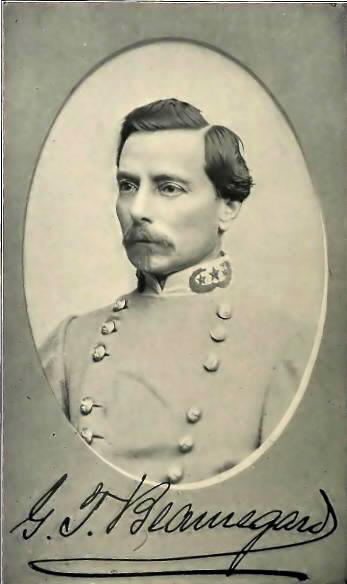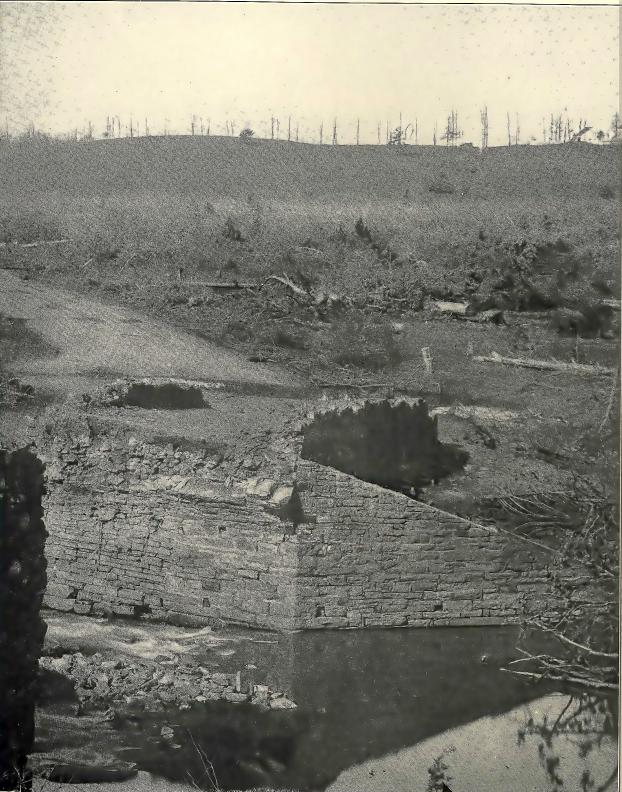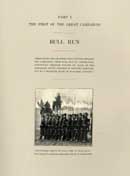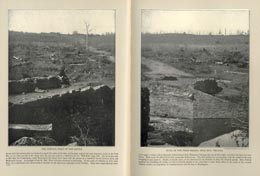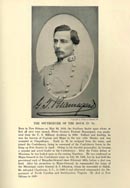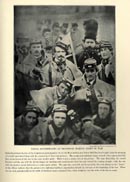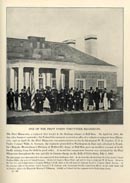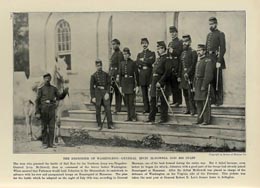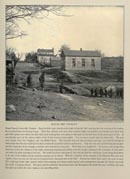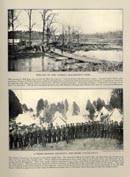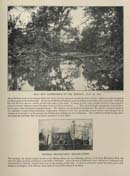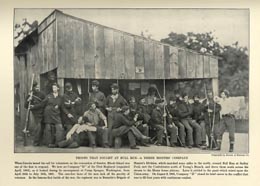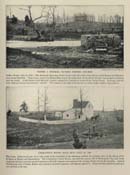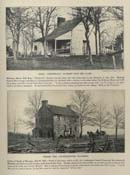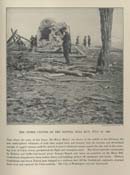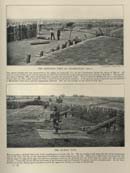The Battle of Bull Run
![]()
This Site:
The Battle of Bull Run - The Volunteers Face the Fire[Back to Civil War Pictures]
For the first time in the nation's history the newly-elected President had entered the capital city by night and in secret, in the fear of the assassin's plots. For the first time he had been inaugurated under a military guard. Then came the opening shots, and the ruined walls of the noble fort in Charleston harbor told the story of the beginnings of the fratricidal war. The fall of Sumter, on April 14, 1861, had aroused the North to the imminence of the crisis, revealing the danger that threatened the Union and calling forth a determination to preserve it. The same event had unified the South; four additional States cast their lot with the seven which had already seceded from the Union. Virginia, the Old Dominion, the first born of the sisterhood of States, swung into the secession column but three days after the fall of Sumter; the next day, April 18th, she seized the arsenal at Harper's Ferry and on the 20th the great navy-yard at Norfolk. Two governments, each representing a different economic and political idea, now stood where there had been but one—the North, with its powerful industrial organization and wealth; the South, with its rich agricultural empire. Both were calling upon the valor of their sons. At the nation's capitol all was confusion and disorder. The tramp of infantry and the galloping of horsemen through the streets could be heard day and night. Throughout the country anxiety and uncertainty reigned on all sides. Would the South return to its allegiance, would the Union be divided, or would there be war? The religious world called unto the heavens in earnest prayer for peace; but the rushing torrent of events swept on toward war, to dreadful internecine war. The first call of the President for troops, for seventy-five thousand men, was answered with surprising alacrity. Citizens left their farms, their workshops, their counting rooms, and hurried to the nation's capital to take up arms in defense of the Union. A similar call by the Southern President was answered with equal eagerness. Each side believed itself in the right. Both were profoundly sincere and deeply in earnest. Both have won the respect of history. After the fall of Fort Sumter, the two sides spent the spring months marshaling their forces for the fierce conflict that was to follow. President Lincoln had called for three-months' volunteers; at the beginning of July some thirty thousand of these men were encamped along the Potomac about the heights of Arlington. As the weeks passed, the great Northern public grew impatient at the inaction and demanded that Sumter be avenged, that a blow be struck for the Union. The "call to arms" rang through the nation and aroused the people. No less earnest was the feeling of the South, and soon two formidable armies were arrayed against each other, only a hundred miles apart at Washington and at Richmond. The commander of the United States Army was Lieut.-General Winfield Scott, whose military career had begun before most of the men of '61 had been born. Aged and infirm, he remained in Washington. The immediate command of the army was entrusted to Brigadier-General Irvin McDowell. Another Union army, twenty thousand strong, lay at Martinsburg, Virginia, under the command of Major-General Patterson, who, like General Scott, was a veteran of the War of 1812 and of the Mexican War.
After a two days' march, with "On to Richmond" as their battle-cry, the army halted at the quiet hamlet of Centreville, twenty-seven miles from Washington and seven miles from Manassas Junction where lay the waiting Confederate army of similar composition—untrained men and boys. Men from Virginia, from North and South Carolina, from the mountains of Tennessee, from Alabama, Mississippi, and Georgia, even from distant Arkansas, had gathered on the soil of the Old Dominion State to do battle for the Southern cause. Between the two armies flowed the stream of Bull Run, destined to give its name to the first great battle of the impending conflict. The opposing commanders, McDowell and Beauregard, had been long-time friends; twenty-three years before, they had been graduated in the same class at West Point. Beauregard knew of the coming of the Federal army. The news had been conveyed to him by a young man, a former government clerk at Washington, whose sympathies, however, lay with the cause of the South. He won the confidence of Beauregard. The latter sent him to the capitol city bearing a paper with two words in cipher, "Trust Bearer." With this he was to call at a certain house, present it to the lady within, and wait a reply. Traveling all night, he crossed the Potomac below Alexandria, and reached the city at dawn, when the newsboys were calling out in the empty streets the latest intelligence of the army. The messenger rang the doorbell at a house within a stone's throw of the White House and delivered the scrap of paper to the only one in the city to whom it was intelligible. She hurriedly gave the youth his breakfast, wrote in cipher the words, "Order issued for McDowell to march upon Manassas tonight," and giving him the scrap of paper, sent him on his way. That night the momentous bit of news was in the hands of General Beauregard. He instantly wired President Davis at Richmond and asked that he be reinforced by Johnston's army. As we have seen, General Scott had arranged that Patterson detain Johnston in the Valley. He had even advised McDowell that "if Johnston joins Beauregard he shall have Patterson on his heels." But the aged Patterson was unequal to the task before him. Believing false reports, he was convinced that Johnston had an army of thirty-five thousand men, and instead of marching upon Johnston at Winchester he led his army to Charlestown, twenty miles in the opposite direction. Johnston thereupon was free to join Beauregard at Manassas, and be promptly proceeded to do so. McDowell's eager troops had rested at Centreville for two days. The time for them to test their mettle in a general engagement was at hand. Sunday, July 21st, was selected as the day on which to offer battle. At half-past two in the morning the sleeping men were aroused for the coming conflict. Their dream of an easy victory had already received a rude shock, for on the day after their arrival a skirmish between two minor divisions of the opposing armies had resulted in the retreat of the Union forces after nineteen of their number lay dead upon the plain. The Confederates, too, had suffered and fifteen of their army were killed. But patriotic enthusiasm was too ardent to be quenched by such an incident, and eagerly, in the early dawn of the sultry July morning, they marched toward the banks of the stream on which they were to offer their lives in the cause of their country. The army moved out in three divisions commanded by Generals Daniel Tyler, David Hunter, and S. P. Heintzelman. Among the subordinate officers was Ambrose E. Burnside, who, a year and five months later, was to figure in a far greater and far more disastrous battle, not many miles from this same spot; and William T. Sherman, who was to achieve a greater renown in the coming war. On the Southern side we find equally striking, characters. General Joseph E. Johnston was not held by Patterson in the Valley and with a portion of his army had reached Manassas on the afternoon of the 20th. In the Indian wars of Jackson's time Johnston had served his country; like McDowell and Beauregard, he had battled at the gates of Mexico; and like the latter he chose to cast his lot with the fortunes of the South. There, too, was Longstreet, who after the war was over, was to spend many years in the service of the country he was now seeking to divide. Most striking of all was " Stonewall " Jackson, whose brilliant military career was to astonish the world. The Stone Bridge over Bull RunThe Union plan for this fateful July day was that Tyler should lead his division westward by sway of the Warrenton turnpike to a stone bridge that crossed Bull Run, about four miles from Centreville. At the same time the main army under Hunter and Heintzelman was to make a detour of several miles northward through a dense forest to a ford of Bull Run, known as Sudley's Ford. Here they were to cross the stream, march down its right bank and, while Tyler guarded the Stone Bridge, engage the foe on the west side of Bull Run. The plan of the battle was admirably drawn, but the march around to Sudley's Ford was slower than had been expected, and it was ten o'clock before the main army reached the point west of the Stone Bridge. While the Federals were making their plans to attack the Confederate left wing, Generals Beauregard and Johnston were planning an aggressive movement against the left wing of the Federal army. They were to cross Bull Run by fords several miles below the Stone Bridge and attack the Northern troops on the weaker wing of the Union force in an effort to rout them before relief could be sent from the Federal right. The Confederate attack was planned to take place a few hours later than McDowell had decided to move. The Southern troops were preparing to cross the stream when the boom of cannon at the Stone Bridge told that the Federals had taken the aggressive and that the weak Confederate left was in danger of being overwhelmed by the superior numbers of the Union right wing. Orders countermanding the command to attack were quickly sent to the Southerners at the lower fords, and preparations were hurriedly made to repulse the attack of the Northern force. Tyler reached the Stone Bridge before six in the morning and opened fire on a Confederate force under Colonel Evans on the other side of the run. For some time this was kept up, and Evans was much puzzled that the Federals did not attempt to cross the bridge; they merely kept up a desultory fire. The failure of the Union troops to advance led Evans to believe that Tyler's attack was only a feint and that the real attacking force would approach from some other direction. This belief was confirmed when he descried a lengthening line of dust above the tree-tops far in the distance, north of the Warrenton turnpike. Evans was now convinced (and he was right) that the main Union army was marching to Sudley's Ford, three miles above the Stone Bridge, and would reach the field from that direction. Quickly then he turned about with six companies of brave South Carolinians and a battalion of "Louisiana Tigers" and posted them on a plateau overlooking the valley of Young's Branch, a small tributary of Bull Run. Here, not far from the Matthews and Carter houses, he awaited the coming of the Federals. His force was stationed overlooking the Sudley and New-market road and an open field through which the Federal troops would be forced to pass to reach the higher ground held by the Confederates. Two 6-pound howitzers were placed to sweep the field of approach, one at each end of Evans' line of defense. With guns loaded, and howitzers ready to pour their charges into an advancing force, the Southerners stood and watched the line of dust that arose above the trees. It moved slowly to the westward. Then, where the Sudley road turns to the southward to cross the Sudley Ford. it followed the trend of the highway. It reached the crossing of Bull Run, and the line of dust faded as the Federals spread into battle-line behind the expanse of woodland that hid each column from the other's view. It was nearing ten o'clock. The rays of the summer sun were beating in sweltering heat upon the waiting troops. Those who could find shelter beneath the trees moved from their places into the shade. Heavy banks of storm clouds were gathering on the horizon, giving promise of relief from oppressive warmth. A silence settled over the ranks of the Confederates as they watched the edge of the woodland for the first appearance of the approaching troops. Suddenly there was a glimmer of the sunlight reflected from burnished steel among the trees. Then, in open battle array, the Federal advance guard, under the command of Colonel Burnside, emerged from the wood on a neighboring hill, and for the first time in the nation's history two hostile American armies faced each other in battle array. At Fort Sumter only the stone walls had suffered; not a drop of human blood was shed. But here was to be a gigantic conflict, and thousands of people believed that here on this field on this day would be decided the fate of the Union and the fate of the Confederacy. The whole country awaited in breathless expectancy the news of this initial conflict, to become known as the battle of Bull Run. With little delay the battle opened. The Federals had a clear advantage in numbers as their outlying forces came up; but they met with a brave resistance. General Bee, of South Carolina, with two brigades, crossed a valley to the south of Evans in the face of a heavy artillery fire to a point within one hundred yards of the Federal lines. At this short range thousands of shots were fired and many brave men and boys were stretched upon the green. The outcome at this point was uncertain until the Union forces were joined by Heintzelman with heavy reinforcements and by Sherman with a portion of Tyler's division. Bee could now do nothing but withdraw, and in doing so his men fell into great disorder. Cheer after cheer arose from the ranks of the Union army. Meanwhile, Generals Beauregard and Johnston had remained at the right of their line, near Manassas, nearly four miles from the scene of action, still determined to press their attack on the Federal left if the opportunity was offered. As the morning passed and the sounds of conflict became louder and extended further to the westward, it became evident to the Confederate leaders that the Federals were massing all their strength in an effort to crush the left of the Southern army. Plans for an aggressive movement were then abandoned, the commanders withdrawing all their reserve forces from the positions where they had been held to follow up the Confederate attack, and sending them to the support of the small force that was holding back the Federals. After dispatching troops to threaten the Union left, Johnston and Beauregard galloped at full speed to the scene of the battle. They arrived about noon—at the moment when Bee's brigade was fleeing across the valley from the hail of Federal bullets. As the frightened men were running in the utmost disorder, General Bee, seeing Thomas J. Jackson's brigade calmly waiting the onset, exclaimed to his men, "Look at Jackson; there he stands like a stone wall!" The expression spread to the army and to the world, and that invincible soldier has since been known as "Stonewall" Jackson. Beauregard and Johnston found it a Herculean task to rally the fleeing men and reform the lines, but they succeeded at length; the battle was renewed, and from noon till nearly three o'clock it raged with greater fury than before. The fight was chiefly for the possession of the plateau called the Henry hill. Up and down the slopes the two armies surged in the broiling sun. Beauregard, like McDowell on the other side, led his men in the thickest of the fight. A bursting shell killed his horse under him and tore the heel from his boot; he mounted another horse and continued the battle. At half-past two the Confederates had been entirely driven from the plateau, had been pressed back for a mile and a half, and for the second time within three or four hours the Union troops raised the shout of victory. At three o'clock, while McDowell and his men were congratulating themselves on having won the battle, a faint cheering was heard from a Confederate army far across the hills. It grew louder and nearer, and presently the gray lines were seen marching gallantly back toward the scene of the battle from which they had been driven. The thrilling cry then passed through the Union ranks, "Johnston has come, Johnston has come!" and there was terror in the cry. They did not know that Johnston, with two-thirds of his army, had arrived the day before; but it was true that the remaining third, twenty-three hundred fresh troops, had reached Manassas at noon by rail, and after a forced march of three hours, under the command of Kirby Smith, had just united with the army of Beauregard. It was this that caused the cheering and determined Beauregard to make another attack on the Henry plateau. The Union men had fought valiantly in this, their first battle, untrained and unused to warfare as they were; they bad braved the hail of lead and of bursting shells; they had witnessed their comrades, their friends, and neighbors fall at their feet to rise no more. They nevertheless rejoiced in their success. But with the long march and the five hours' fighting in the scorching July sun they were weary to exhaustion, and when they saw the Confederates again approaching, reinforced with fresh troops, their courage failed and they began to retreat down the hill. With waving colors the Confederates pressed on, opening a volley of musketry on the retreating Federals, and following it with another and another. In vain McDowell and his officers attempted to rally his panic-stricken men and reform his lines. Only the regulars, about sixteen hundred in number, were subject to the orders of their superiors, and they made a brave stand against the oncoming foe while they covered the retreat of the disorganized mass. On the Henry hill were the two powerful batteries of Griffin and Ricketts. They had done most valiant service while the tide of battle ebbed and flowed. But at last their hour had come. A Confederate regiment, dashing from a neighboring hill, poured in a deadly volley, cut down the cannoneers almost to a man, killed their horses, and captured the guns. A few minutes later General Beauregard rode up to the spot and noticed Captain Ricketts lying on the ground, desperately wounded. The two men had been friends in the years gone by. Beauregard, recognizing his old friend, asked him if he could be of any service. He then sent his own surgeons to care for the wounded captain and detailed one of his staff to make him comfortable when he was carried to Richmond as a prisoner of war. There is little more to relate of the battle of Bull Run. In his report McDowell stated that after providing for the protection of the retreat from the battlefield by Porter's and Blenker's volunteer brigades, he took command in person of the force previously stationed for holding the road back to Centreville and made such disposition "as would best serve to check the enemy," at the Centreville ridge. Some hundreds of civilians, members of Congress and others, had come out from Washington to witness a victory for the Grand Army, and they saw that army scattered in wild flight to escape an imaginary pursuer. The Confederates made no serious effort to follow after them, for the routed Federals had destroyed the Stone Bridge as they passed it in their retreat, and had obstructed the other avenues of pursuit. As darkness settled over the field the Confederates returned to their camps. McDowell made a desperate effort to check and reorganize his army at Centreville, but he was powerless. The troops refused to listen to any commands; they rushed on and great numbers of them traveled all night, reaching Washington in the morning. These raw troops had now received their first baptism of blood and fire. Nearly five hundred of their number were left dead on the field of battle, and fourteen hundred were wounded. The captured and missing brought the Federal loss to nearly three thousand men. The Confederate loss in killed, wounded, and missing was less than two thousand. The Federal forces engaged were nearly nineteen thousand, while the Confederates had more than eighteen thousand men on the field. The Confederate victory at Bull Run did the South great injury in that it led vast numbers to believe the war was over and that the South had won. Many soldiers went home in this belief, and for months thereafter it was not easy to recruit the Southern armies. The North, on the other hand, was taught a needed lesson—was awakened to a sense of the magnitude of the task before it. The first great battle of the American Civil War brought joy to the Confederacy and grief to the States of the North. As the Federal troops marched into Washington through a drenching downpour of rain, on July 22d, the North was shrouded in gloom. But the defeated army had not lost its courage. The remnants of the shattered forces were gathered, and from the fragments a mightier host was to be rallied under the Stars and Stripes to meet the now victorious foe on future battlegrounds. |
|
|
|
![]()
|
Copyright © 2003-2018 Son of the South. Email us at: paul@sonofthesouth.net.
|
|
|
|
Are you Scared and Confused? Click Here to read My Snake Story, a story of hope and encouragement, to help you face your fears. |
||
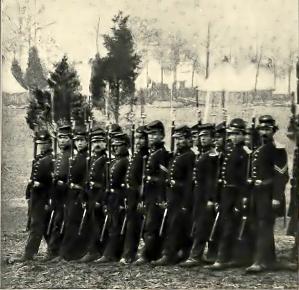 THERE
had been strife, a bloodless, political strife, for forty years between
the two great sections of the American nation. No efforts to reconcile
the estranged brethren of the same household had been successful. The
ties that bound the great sections of the country had severed one by
one; their contention had grown stronger through all these years, until
at last there was nothing left but a final appeal to the arbitrament of
the sword; then came the great war, the greatest civil war in the annals
of mankind.
THERE
had been strife, a bloodless, political strife, for forty years between
the two great sections of the American nation. No efforts to reconcile
the estranged brethren of the same household had been successful. The
ties that bound the great sections of the country had severed one by
one; their contention had grown stronger through all these years, until
at last there was nothing left but a final appeal to the arbitrament of
the sword; then came the great war, the greatest civil war in the annals
of mankind. 